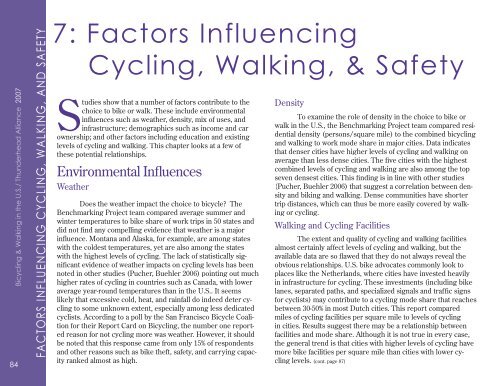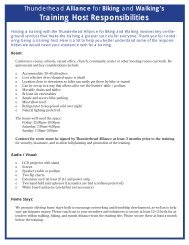2007 Benchmarking Report - Alliance for Biking & Walking
2007 Benchmarking Report - Alliance for Biking & Walking
2007 Benchmarking Report - Alliance for Biking & Walking
You also want an ePaper? Increase the reach of your titles
YUMPU automatically turns print PDFs into web optimized ePapers that Google loves.
Bicycling & <strong>Walking</strong> in the U.S./ Thunderhead <strong>Alliance</strong> <strong>2007</strong><br />
84<br />
FACTORS INFLUENCING CYCLING, WALKING, AND SAFETY<br />
7: Factors Influencing<br />
Cycling, <strong>Walking</strong>, & Safety<br />
Studies show that a number of factors contribute to the<br />
choice to bike or walk. These include environmental<br />
influences such as weather, density, mix of uses, and<br />
infrastructure; demographics such as income and car<br />
ownership; and other factors including education and existing<br />
levels of cycling and walking. This chapter looks at a few of<br />
these potential relationships.<br />
Environmental Influences<br />
Weather<br />
Does the weather impact the choice to bicycle The<br />
<strong>Benchmarking</strong> Project team compared average summer and<br />
winter temperatures to bike share of work trips in 50 states and<br />
did not find any compelling evidence that weather is a major<br />
influence. Montana and Alaska, <strong>for</strong> example, are among states<br />
with the coldest temperatures, yet are also among the states<br />
with the highest levels of cycling. The lack of statistically significant<br />
evidence of weather impacts on cycling levels has been<br />
noted in other studies (Pucher, Buehler 2006) pointing out much<br />
higher rates of cycling in countries such as Canada, with lower<br />
average year-round temperatures than in the U.S.. It seems<br />
likely that excessive cold, heat, and rainfall do indeed deter cycling<br />
to some unknown extent, especially among less dedicated<br />
cyclists. According to a poll by the San Francisco Bicycle Coalition<br />
<strong>for</strong> their <strong>Report</strong> Card on Bicycling, the number one reported<br />
reason <strong>for</strong> not cycling more was weather. However, it should<br />
be noted that this response came from only 15% of respondents<br />
and other reasons such as bike theft, safety, and carrying capacity<br />
ranked almost as high.<br />
Density<br />
To examine the role of density in the choice to bike or<br />
walk in the U.S., the <strong>Benchmarking</strong> Project team compared residential<br />
density (persons/square mile) to the combined bicycling<br />
and walking to work mode share in major cities. Data indicates<br />
that denser cities have higher levels of cycling and walking on<br />
average than less dense cities. The five cities with the highest<br />
combined levels of cycling and walking are also among the top<br />
seven densest cities. This finding is in line with other studies<br />
(Pucher, Buehler 2006) that suggest a correlation between density<br />
and biking and walking. Dense communities have shorter<br />
trip distances, which can thus be more easily covered by walking<br />
or cycling.<br />
<strong>Walking</strong> and Cycling Facilities<br />
The extent and quality of cycling and walking facilities<br />
almost certainly affect levels of cycling and walking, but the<br />
available data are so flawed that they do not always reveal the<br />
obvious relationships. U.S. bike advocates commonly look to<br />
places like the Netherlands, where cities have invested heavily<br />
in infrastructure <strong>for</strong> cycling. These investments (including bike<br />
lanes, separated paths, and specialized signals and traffic signs<br />
<strong>for</strong> cyclists) may contribute to a cycling mode share that reaches<br />
between 30-50% in most Dutch cities. This report compared<br />
miles of cycling facilities per square mile to levels of cycling<br />
in cities. Results suggest there may be a relationship between<br />
facilities and mode share. Although it is not true in every case,<br />
the general trend is that cities with higher levels of cycling have<br />
more bike facilities per square mile than cities with lower cycling<br />
levels. (cont. page 87)



